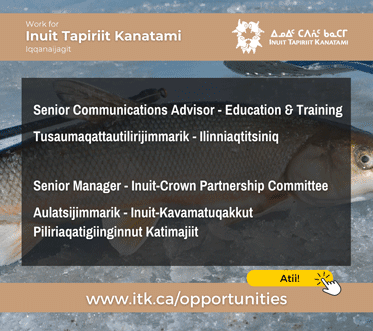Exploring the explorer’s mind
An exhibition of Vilhjálmur Stefansson’s diaries and photographs shows that while learning about the Inuit of the Canadian Arctic, he also learned about himself
Noted Icelandic explorer and anthropologist Vilhjálmur Stefansson was often asked if he had reached the North Pole during his frequent travels to the Canadian North.
He replied that he was a scientist, not a tourist.
Known as the “Prophet of the North,” Stefansson changed the popular Southern image of the Arctic, and gave Western audiences a glimpse of the life and culture of the Inuit people who came to be his friends.
Stefansson’s teachings about the Inuit way of life were not well received by his contemporaries in the early 1900s. Many Arctic explorers of the time were more interested in conquering new lands than learning about new cultures.
But his observations are just as relevant today as they were almost 100 years ago, and the crowd gathered at Iqaluit’s Nunatta Sunakkutaangit Museum on Feb. 16 was much more receptive to the message than last century’s audiences.
Until March 31, the museum will host “The Friendly Arctic: Vilhjálmur Stefansson’s Legacy and Vision,” an exhibition of the explorer’s journal entries and hand-coloured photographs. The exhibit is a joint project of Iceland’s Stefansson Arctic Institute and the Stefansson Collection at New Hampshire’s Dartmouth College.
Funding for the Iqaluit exhibition came from the city of Reykjavik, the town of Akureyri and the Icelandic ministry of foreign affairs. Hjalmar Hannesson, Iceland’s ambassador to Canada was in town to open the exhibition.
Controversial, often deliberately provocative, Hannesson said, Stefansson was a man with a touch of genius. He predicted the coming of direct flights over the Arctic and that submarines would one day travel below the frozen Arctic ice.
“He, perhaps more than anyone else, changed the image of the North from a barren eternally frozen wasteland into a region of diverse character which deserves the attention of the international community,” Hannesson said.
“Say that experience is the best teacher, many advocating learning by doing; but I have always been a great believer in having few teachers on my backs. In my time there were no books telling how seals should be hunted, but I had good teachers in the Eskimos… But even better teachers than the Eskimos were the seals themselves.” — Dec. 20, 1906
As an anthropology student at Harvard University, Stefansson began his career as an explorer with expeditions to his homeland in 1904 and 1905. In 1906-07, he made the first of several trips to northern Canada, spending the winter among the Inuit of the Mackenzie Delta.
He spent 10 winters and seven summers in the Canadian northwest, in the area now known as Nunavut. On a trip spanning the years 1908 to 1912, he became the first anthropologist to study the culture and community of the Copper Inuit of Victoria Island. (In 1952, the Canadian government named an island just north of Victoria Island after him.)
“My own constant effort has been acquiring a knowledge of the language – rather it’s nature than of its vocabulary, for I have decided that a pretentious dictionary is not worth attempting.” — Feb. 15, 1912
Stefansson soon became familiar with the Inuit language. He wrote 20 books and almost 400 articles on Arctic topics. His book Hunters of the Great North, as well as a number of articles, describe his stay with the Inuit.
“Marriage relations: It seems to be customary that the man who marries the youngest of only daughter must attach himself to the parent’s family. If he is later unwilling to go where they go, the girl nevertheless goes with her parents.” — March 7, 1907
The explorer lived for a while with an Inuit woman named Fannie Pannigabluk. Stefansson researchers have called her his seamstress, travel companion and ethnographic informant. The couple is reported to have been married in traditional Inuit style, and together had one son, Alex Stefansson.
“Sometimes the doctor is called. He works in the patient’s house and his treatment consists in songs and dances. While he is at work, no one must leave the house, though the doctor himself often goes out, goes around the house and comes in again. The dance ordinarily lasts from about 7 p.m. to 1 a.m. Occasionally it may be longer.” Oct. 8, 1906
For the most part, Stefansson observed the Inuit, their customs and practices. His observations involved taking cephalic measurements, or recording the size of the circumference of the head. He writes that several young boys seemed unconcerned by his strange request to measure their heads, however, his journals do not say what the measurements were used for.
“The knife-fork-and-plate prejudices have left me and my fingers have been fork and dish for some time now.” Dec. 21, 1906
In the course of his 32 million steps, the 32,000 kilometres of Arctic terrain he covered by foot and dog sled, Stefansson struggled with loneliness and despair, researchers maintain, while also feeling affection, friendship and joy.
He found a new home in the North. But when his travels were done, he returned to the United States, where he studied and made his home.
“In a year or two, the Eskimo would go to the traders if the traders did not come to the Eskimo. And if neither Eskimo nor trader had the enterprise to seek the other, the Indians are eager to act as middleman between. Commerce in goods may therefore be said to have begun; commerce of ideas cannot help following close behind.” — April 10, 1910





(0) Comments